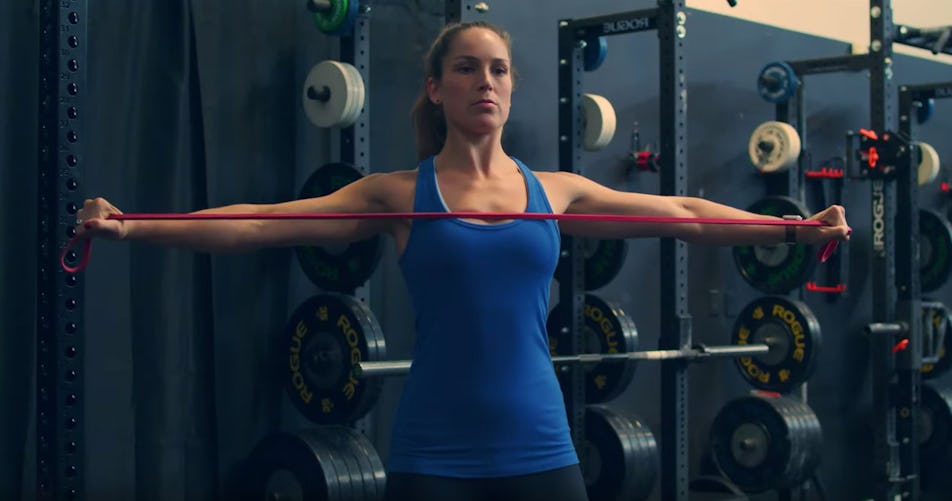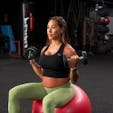Guys want shoulders like boulders. Gals just want bolder shoulders. And that’s what these workouts are designed to do: build muscle to help you get a rounder, fuller look to your shoulders, prevent injuries, and strengthen your ability to push and pull. You don’t need heavy weights, high-tech machines, or long workouts that isolate the deltoids from every angle—leave that to bodybuilders. You can build strong, sculpted delts in 30 minutes or less with the routines I wrote for you here.
What Muscles Am I Working?
The shoulder muscles are called the deltoids (or delts, for short). They’re triangle-shaped and originate at the collarbones, acromion joints, spine, and shoulder blades, and insert onto the humerus bones. Each deltoid muscle has three heads—that is, portions of the muscle that have separate sets of muscle fibers and perform a separate, distinct function.
Front deltoid. This portion of the muscle lies on the front of the shoulder, above the pectorals. It flexes the shoulder, raising the arm in front of the body and assists the pecs (chest) and lats (back) in rotating it internally. All pressing exercises, as well as front raise movements, will emphasize the front delts.
Lateral deltoid. The middle-head of the deltoid appears on the outermost side of the shoulder, between the front and rear delts. (Interestingly, while gym rats often refer to it as the “medial delt,” this term is technically inaccurate, as it’s actually the portion of the muscle that is furthest from the midline of the body.) The lateral deltoid raises the arm out to the side when the shoulder is internally rotated. It also does this when the shoulder is externally rotated (such as when your elbows are bent 90 degrees and you move your arms apart—imagine a “stick up” position, and you’re the one getting robbed!). Lateral raises are the primary exercise for hitting the middle (“side”) delts.
Posterior deltoid. The rear delt sits on the back side of the shoulder. It helps the lats extend the shoulder, moving your arm behind you, as in a rowing motion.
Benefits Of Working Out Your Shoulders
Should you require them to, strong shoulders will do more than make you look athletic in sleeveless shirts and tops. They help you carry all kinds of heavy things (groceries, luggage, your toddler), as well as reach, throw, punch, and press things. Best of all, they can help to prevent injury in any sports you play, even if they’re just weekend warrior activities like golf or softball. The shoulder joints are highly mobile, but as a consequence, are some of the most unstable joints in the body. Strong detloids help to hold them in position, and allow the the shoulders to absorb force more safely.
According to a 2013 study, since the year 2000, serious shoulder injuries have increased by five times among youth baseball and softball players. Strength training the shoulders is one of the best preventive measures to reduce injury risk.
The Best Shoulder-Strengthening Exercises
The following are my picks for the best shoulder moves for women.
#1 Lateral Raise
You know these already. There may be no better exercise for hitting the lateral head of the deltoid—the middle part that really gives your shoulders some width when looking at them from the front. If you feel a little pinch in your shoulders doing these, try bending your hips a bit so your torso leans forward. This should alleviate some pressure on the joints. Another tip: don’t squeeze the dumbbell handles too hard. Think of your hands as merely hooks to hold the weight. That way, your deltoids will take on more of the load (it won’t be dispersed to your hands and forearms).
Dumbbell lateral raises are tried and true, but you can also perform the lateral raise motion one arm at a time using a barbell in a landmine unit. In this instance, you lift the bar as if it were a long lever, which offers a number of benefits. For one thing, the movement becomes more strict—you can’t really get sloppy and swing the weight up like you might have a tendency to do with dumbbells. For another, you get to work the deltoids in three planes of motion in the same exercise. Most shoulder moves have you lifting weights either out to the sides or overhead, but a landmine lateral raise has a bar path that goes forward and rotates to the side—so it works all the deltoid musculature while still isolating the stress of the exercise to the shoulder. For more on this movement, see The Best Full-Gym Shoulder Workout For Women below.
#2 Landmine Press
There’s nothing wrong with pressing a barbell overhead, but some people find that it can irritate their shoulders, wrists, and elbows. Performing the same motion with a barbell in a landmine allows you to use a neutral grip, which lets your humerus bone glide through your shoulder joints more smoothly (there’s less risk of impingement). The press is also done on an arc, a more natural movement that strengthens the deltoids with less stress on the joints, and, in some cases, may even give you greater range of motion.
Landmine presses are great for getting your shoulder blades to move when you press, which doesn’t happen when you press off a bench or with some machines. Shoulder blade movement is important for any athletic activity you do (throwing, punching, etc.) You can do landmine presses with both arms, one arm at a time, standing up, or, as we show above and in the Full-Gym Shoulder Workout, in a half-kneeling position, which is good for learning the exercise, training your core, and stretching out your hip flexors to boot.
#3 Band Pull-Apart
You’ve heard the expression that too much of anything is not good for you, and that certainly applies to most exercises—but it isn’t so with the band pull-apart. It works the rear delts as well as the upper back, and since these areas are a weak point in virtually everyone, and pull-aparts aren’t stressful to any joints, you can pretty much do them as much as you want. The more total reps you do, the better your posture will become, and the more you’ll fill out the back of your shoulders (which probably look somewhat lopsided, as most of us inadvertently do much more work for the front delts than we do for the rear).
Pull-aparts are also easy to progress and regress. Choke up on the band more to increase the difficulty, and widen your grip to make it easier. You can even do both in the same set, starting with a lot of band tension and then reducing it as you fatigue to keep pumping out reps. As you only need a band to perform them, the pull-apart is easily done at home, so it appears in our At-Home Workout below.
#4 Rear-Delt Fly
These work similarly to the pull-apart, but can be done with dumbbells, cables, or even gymnastics rings. To really emphasize the rear delts, do them with your upper back rounded and your chest supported on a bench—don’t let your shoulder blades pinch together as you raise the weights; just lift with the shoulders and stop short of 90 degrees. To hit the rear delts and upper back together, lift all the way to 90 degrees and squeeze your back at the top (as shown above). Variations of the rear-delt fly appear in every workout to ensure balanced shoulder development.
How to Stretch Out Before Training Your Shoulders
Onnit Durability Coach Natalie Higby (@nat.trill.fit on Instagram) offers these two mobility drills to increase range of motion and stability in your shoulders and upper back.
The Best Bodyweight Shoulder Workout For Women
Pressing exercises are most people’s main go-to for shoulder training, but pushup variations work the deltoids hard as well. Change the angles you push at, and you can hit every corner of the delts. Another benefit of pushups is that they’re a closed-chain exercise. Because your hands are fixed to the ground when you do pushup exercises, you get greater overall muscle activation. Every rep not only works the shoulders, but your core as well, since it must fire to stabilize your bodyweight during the movement. The following routine requires only a floor and a wall to complete.
Directions
The workout is made up of 2 circuits. To perform a circuit, do one set for each exercise in the group, resting briefly between each, and then rest a minute (or more if needed) after you’ve completed the last exercise in the group. Repeat for the prescribed number of sets, and then go on to the next circuit.
After you’ve done both circuits, do the wall walkup as the last exercise.
Circuit #1
1. Plank Shoulder Tap
Sets: 3 Reps: 16–20
Step 1. Get into pushup position—hands under your shoulders and legs extended behind you. Tuck your pelvis slightly so that it’s perpendicular to the floor and brace your abs.
Step 2. Holding the position, alternate reaching one hand up to tap the opposite shoulder. Each tap is one rep.
2. Pike Pushup
Sets: 3 Reps: 10
Step 1. Get into pushup position and bend your hips, sending your butt up in the air as high as possible. Spread your fingers wide and push into the floor to activate your shoulders.
Step 2. Lower your head toward the floor until the top of it touches down gently. Tuck your elbows toward your sides as you lower. Press your body back up.
3. Superman Y-Raise
Sets: 3 Reps: 12
Step 1. Lie facedown on the floor and extend your arms in front of you to form a Y shape with thumbs pointing up.
Step 2. Raise your chest and legs off the floor, contracting your lower back and driving your shoulder blades down and together as you lift your arms up. Hold for a moment, and then return to the floor.
Circuit #2
1. Bear Pushup
Sets: 4 Reps: 8–10
Step 1. Get into pushup position, and then bend your knees and push your hips back so that your butt is close to your heels (you’ll look like a bear stretching its back).
Step 2. Push yourself forward again and lower into the bottom position of a pushup.
Step 3. Push yourself back up and into the bear position again.
2. Superman T-Raise
Sets: 4 Reps: 12
Step 1. Lie on the floor face down and extend your arms out 90 degrees to your sides.
Step 2. Raise your torso off the floor while simultaneously lifting your legs. Hold for a moment, and then return to the floor.
Finisher
Wall Walkup
Sets: 4 Reps: 10
Step 1. Get into pushup position with your feet touching a wall behind you. Tuck your tailbone slightly so that your pelvis is perpendicular to the floor and brace your abs.
Step 2. Begin walking your feet up the wall behind you as you push your body backward. Go as far up the wall as you can while keeping your core tight—don’t let your lower back overextend. Walk your hands forward again to return your body to the floor. Go slowly and control the movement. Each trip up the wall and back is one rep.
If this feels too easy, add a handstand pushup at the top position, when your torso is nearly vertical against the wall.
The Best At-Home Shoulder Workout For Women
This routine works whether you have a well-equipped home gym or are visiting your geat Aunt Tilly and only have access to two rusty, pink dumbbells she’s been using as a doorstop in the guest room. You’ll need to get some elastic exercise bands (if you don’t travel with them already, start!), but the weighted exercises don’t need much load to be effective. If you’re stuck with really light weights, just perform your reps more slowly, and really focus on making your form perfect. You can also shorten your rest periods between exercises and circuits to increase the intensity.
Directions
The workout is made up of 3 circuits. To perform a circuit, do one set for each exercise in the group, resting briefly between each, and then rest a minute (or more if needed) after you’ve completed the last exercise in the group. Repeat for the prescribed number of sets, and then go on to the next circuit.
Circuit #1
1. Banded Face Pull
Sets: 3 Reps: 10
Step 1. Attach an elastic exercise band to a sturdy object at about face level. Grasp the loop end with both hands and step back to put tension on the band. Bend your knees slightly to help you keep balance, and maintain an upright torso.
Step 2. Pull the band toward you until your upper back is fully contracted, and then control its return as you extend your arms.
2. Band Pull-Apart
Sets: 3 Reps: 10
Step 1. Hold a band with hands shoulder-width apart. Extend your arms in front of you. Draw your shoulder blades together and downward (think: “proud chest”).
Step 2. Extend your arms out to your sides, pulling the band apart.
Circuit #2
1. Overhead Press
Sets: 4 Reps: 10
Step 1. Hold a barbell with hands shoulder-width apart. You can take the bar off a rack, or, if you don’t have one, simply pick the bar up off the floor and clean it to shoulder level. Stand with feet shoulder-width apart and tuck your tailbone slightly so that your pelvis is parallel to the floor. Draw your ribs down and brace your core.
Step 2. Press the bar overhead, pushing your head forward as the bar clears it so that the bar ends up just behind your head in the lockout position.
Note: am empty barbell may be enough load for you, especially if it’s an Olympic bar (45 pounds), but any type of barbell is OK. If you don’t have a barbell at home, perform the same movement with two dumbbells.
2. Bottoms-Up Press
Sets: 4 Reps: 10
Step 1. Hold a light kettlebell in each hand by its handle and clean them up to shoulder level so they’re balancing upside down. (You’ll have to squeeze the handles hard to keep them balanced.) Stand with feet shoulder-width apart and tuck your tailbone slightly so that your pelvis is parallel to the floor. Draw your ribs down and brace your core.
Step 2. Press the weights overhead to lockout, and then lower them with control back to your shoulders.
3. YTL
Sets: 4 Reps: 10 (each letter)
Step 1. Hold small weight plates or very light dumbbells (3 pounds is good) and lie chest-down on a bench. Extend your arms toward the floor.
Step 2. Draw your shoulder blades down and together as you raise your arms up to form a Y shape, level with the floor. Repeat for reps.
Step 3. Raise your arms out 90 degrees to form a T shape. Repeat for reps.
Step 4. Bend your elbows 90 degrees and draw your shoulders down and back, rowing the weights to your sides. Rotate your forearms to face forward (your arms will form an L shape). Repeat for reps.
Circuit #3
1. Lateral Raise
Sets: 3 Reps: 10–12
Step 1. Hold a dumbbell in each hand and stand with feet shoulder-width apart. Bend your hips back slightly while keeping a long spine from your head to your hips.
Step 2. Keeping a slight bend in your elbows, raise your arms out 90 degrees to your sides.
2. 3-Way Shoulder Raise
Sets: 3 Reps: 8–10
Step 1. Hold a dumbbell in each hand and stand with feet shoulder-width apart. Raise the weights out 90 degrees to your sides (a normal lateral raise).
Step 2. From the top of the lateral raise, rotate your arms to face forward (as in a front raise).
Step 3. Raise your arms straight overhead (as in the top of an overhead press).
Step 4. Reverse the entire movement, lowering your arms back in front of you, then reaching out to your sides, and then lowering them to your sides. That’s one rep.
3. Dumbbell Rear-Delt Fly
Sets: 3 Reps: 10
Step 1. Hold a dumbbell in each hand and stand with feet shoulder-width apart. Bend your hips back—while keeping a long spine from your head to your pelvis—until your torso is about parallel to the floor.
Step 2. Draw your shoulder blades back together and downward as you raise the dumbbells out 90 degrees.
The Best Full-Gym Shoulder Workout For Women
If you have access to a fully-stocked gym, you have the greatest number of options at your disposal for the best possible workout. This includes a landmine unit, which will allow you to turn the good, old-fashioned barbell into a more sophisticated piece of exercise equipment with a variety of great uses. (If your gym doesn’t have a landmine, fear not—a corner in the room will work too).
Using the barbell with a landmine will make the lateral raise—a classic dumbbell move—into a three-dimensional exercise that will hit your deltoids in a brand new way, while reducing strain on the shoulder joints. The landmine also makes for more joint-friendly pressing. To that end, I’ll also have you using a power rack—another piece of equipment you’ll likely only be able to access in a gym. Doing barbell overhead presses against the support beams of the rack mimics a Smith machine press, but you still have to control the bar path. This gives you the best of both worlds: the stable, isolated shoulder hit you’d get from machine training, plus the muscle activation and strength component of free weights.
Directions
The workout is made up of 3 circuits. To perform a circuit, do one set for each exercise in the group, resting briefly between each, and then rest a minute (or more if needed) after you’ve completed the last exercise in the group. Repeat for the prescribed number of sets, and then go on to the next circuit.
Circuit #1
1. Landmine Raise
Sets: 3 Reps: 8–10 (each side)
Step 1. Set up a barbell in a landmine unit, or wedge one end into the corner of a wall. Grasp the very end of the sleeve (where you load the weight plates) and stand with feet shoulder-width apart with the end of the bar in front of your hips.
Step 2. Raise your arm up 90 degrees as you would in a normal lateral raise. Note that you’ll probably only be able to use the empty bar or very light weight. Don’t try to go heavy.
2. Half-Kneeling One-Arm Landmine Press
Sets: 3 Reps: 10 (each side)
Step 1. Stand in front of the barbell in a landmine unit, and get into a lunge position with your right leg in front. Lower your body so you rest on one knee in front of the bar, and pick it up to shoulder level with your left hand. Tuck your tailbone slightly so that your pelvis is parallel to the floor and brace your abs. Draw your shoulder blades back together and downward (think: “proud chest”).
Step 2. Press the bar overhead in a semi-circular motion. Think “around the world.” Maintain a tight core and your upright body position and keep your balance.
Circuit #2
1. Scrape-The-Rack Press
Sets: 3 Reps: 10
Step 1. Set a barbell up in a power rack at about face level. Stand with legs staggered and feet shoulder-width apart. Grasp the bar with hands shoulder-width, wrists straight, and elbows pointing down. Draw your shoulder blades down and together and tuck your tailbone slightly so that your pelvis is parallel to the floor. Brace your abs.
Step 2. Press the bar out of the rack and overhead while scraping it against the support beams. You want there to be friction, so push the bar forward as well as overhead. Lower it down the same way.
2. 3-Way Shoulder Raise
Sets: 3 Reps: 10
Step 1. Hold a dumbbell in each hand and stand with feet shoulder-width apart. Raise the weights out 90 degrees to your sides (a normal lateral raise).
Step 2. From the top of the lateral raise, rotate your arms to face forward (as in a front raise).
Step 3. Raise your arms straight overhead (as in the top of an overhead press).
Step 4. Reverse the entire movement, lowering your arms back in front of you, then reaching out to your sides, and then lowering them to your sides. That’s one rep.
3. YTL
Sets: 3 Reps: 8 (each letter)
Step 1. Hold small weight plates or very light dumbbells (3 pounds is good) and lie chest-down on a bench. Extend your arms toward the floor.
Step 2. Draw your shoulder blades down and together as you raise your arms up to form a Y shape, level with the floor. Repeat for reps.
Step 3. Raise your arms out 90 degrees to form a T shape. Repeat for reps.
Step 4. Bend your elbows 90 degrees and draw your shoulders down and back, rowing the weights to your sides. Rotate your forearms to face forward (your arms will form an L shape). Repeat for reps.
Circuit #3
1. Dual-Cable Rear Delt Fly
Sets: 4 Reps: 12
Step 1. Cross your arms in front of you and grasp the ends of the cables on two facing cable stations. Step away from the machines to put tension on the cables.
Step 2. Draw your arms out 90 degrees to your sides, squeezing your shoulder blades together at the end of the range of motion.
2. Cable Rope Front Shoulder Raise
Sets: 4 Reps: 10–12
Step 1. Attach a rope handle to the low pulley of a cable station and straddle it with feet shoulder-width apart. Grasp an end of the rope in each hand.
Step 2. Raise the handle in front of you with arms extended. Go up to shoulder level, and then lower back under control.

)





